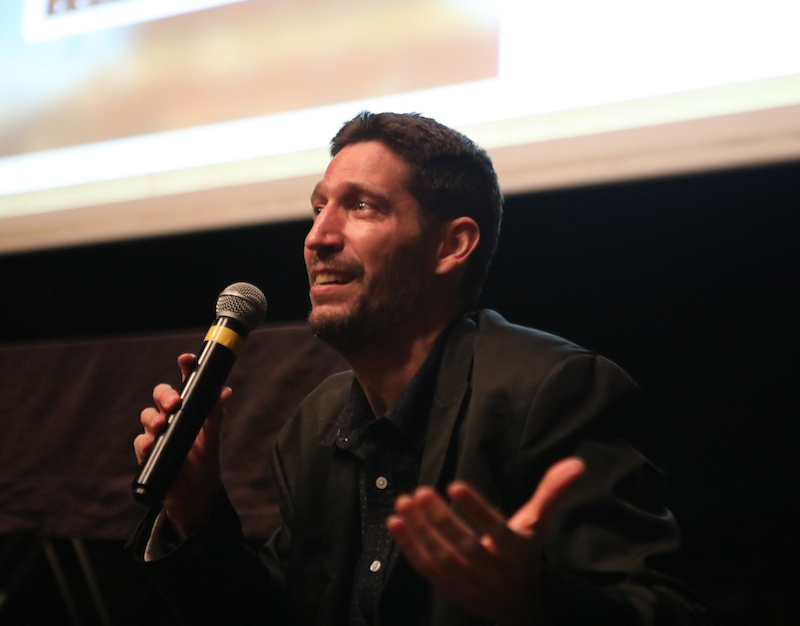Last year, BUG404 hosted Mostra Bug, the first major conference on digital narratives in Brazil, which was held in Rio de Janeiro. In addition to showcasing immersive and interactive projects from around the world, the event also offered workshops with international experts.
Arnau Gifreu, a Catalan researcher on Latin American interactive media from Massachusetts Institute of Technology’s (MIT) Open Documentary Lab, led the workshop "Guidelines for the production of interactive and transmedia projects" at the event.
Gifreu gives lectures and conducts research on new media, and also directed La otra orilla, a transmedia project dedicated to LGBTQ rights in Colombia. The platform features videos, audience interactions, photo series and more.
IJNet spoke to Giferu about the recent boom of new storytelling platforms and methods in Latin America.
IJNet: Why has Latin America been a center of documentary production in the new media era?
Gifreu: In Latin America, there is a compelling need to tell stories. These stories are often nonfiction and connected to events that took place in the past, which created this movement of social documentary filmmakers and activists. It is [connected to] the resurgence of the grassroots, low-cost, self-produced documentary that had its peak in the 1980s and 1990s….This traditional documentary found a new path in the 21st century with new technologies. Interactive media and immersive storytelling, especially when published across multiple platforms, serve as new ways to communicate with their audiences. For me, the focus of these technologies will be in Latin America.

What elements are essential for a documentary to have a real social impact?
The real impact is hard to measure. There are no real statistics on how these projects actually had a social impact, how deep the impact was or what kind of change the project caused. What we are seeing a lot of in immersive and transmedia are projects with a lot of social demands that tell stories that are different from official sources.
The most important element is the narrative, then there are [also] the technological components that make it interactive, which are merely devices that expressing reality. For example, The Quipu Project, the Peruvian interactive documentary about women illegally sterilized during Fujimori's government, had only one phone, one network and one phone number. However, it was a great example of enacting change. They were able to prevent President Fujimori's daughter from being elected president because the film uncovered the truth about her father and suggested that she could have a similar policy to him. In this sense, these [kind of] projects do make a social change.
Do you consider that interactive, immersive and transmedia works have a greater power of transformation?
No, I don't think so. There might be a greater emotional power by encouraging empathy with immersive mechanisms such as virtual reality and augmented reality… However, in the case of The Quipu Project, they only used audio, and the audio is often not even translated from the Quechua language. However, the humanity and connection are so profound that neither the medium nor technology matters. What matters is the discourse of the subjects and the level of depth and vulnerability in these stories. And social media multiplies these voices because now they can be in every corner of the planet through the internet. It is an amplifier that has more power than radio and television. In the past, audience members were just consumers of media, now they can express what they think, and that means adding more elements of emotion and empathy.
What projects stand out for you in Latin America?
There are many productions in Latin America. For example, the works of Mónica González in Mexico, such as Geografía del Dolor, which spotlights people who are missing as a result of drug cartels. There are also very interesting developments in Colombia: 4 Ríos, on the subject of guerrilla warfare and Paciente, a multi-screen, transmedia work on health. Argentina stands out in the Southern Cone, Where a group in Rosario launched the project Documedia, which is dedicated to creating [socially]-focused journalistic documentaries, such as Mujeres en Venta, about sexual exploitation in Argentina. Of course, there's also The Quipu Project in Peru. Brazil’s new media market is still developing, but there are some initiatives, such as Cross Content’s documentary Autorretrato, which focuses on social problems in Rio de Janeiro. More recently, Som dos Sinos, which, for me, is the first great work — a watershed project at the level of aesthetics — in the field of transmedia in Brazil.
For those who want to work with transmedia, immersive and interactive narratives, where should they start?
I would seek training at film and documentary festivals, production workshops — such as Docs Barcelona — hackathons to work on prototypes and begin training in this field and then courses that can be taken in Latin America or Europe. For example, there is EsoDoc in Italy, the University of Rosario in Argentina and the University of Caldas in Colombia.
Jéssica Cruz is a freelance journalist and audiovisual producer for BBC, Travel Channel, Channel 9 and others.
Main image of the exhibition of the documentary "Som dos Sinos." Secondary image of the lecture "Nonfiction Narratives in Latin America: An Interactive Journey through the Reality of South and Central America" with Arnau Gifreu at Mostra Bug in Rio de Janeiro. Both courtesy of Felipe Varanda.

